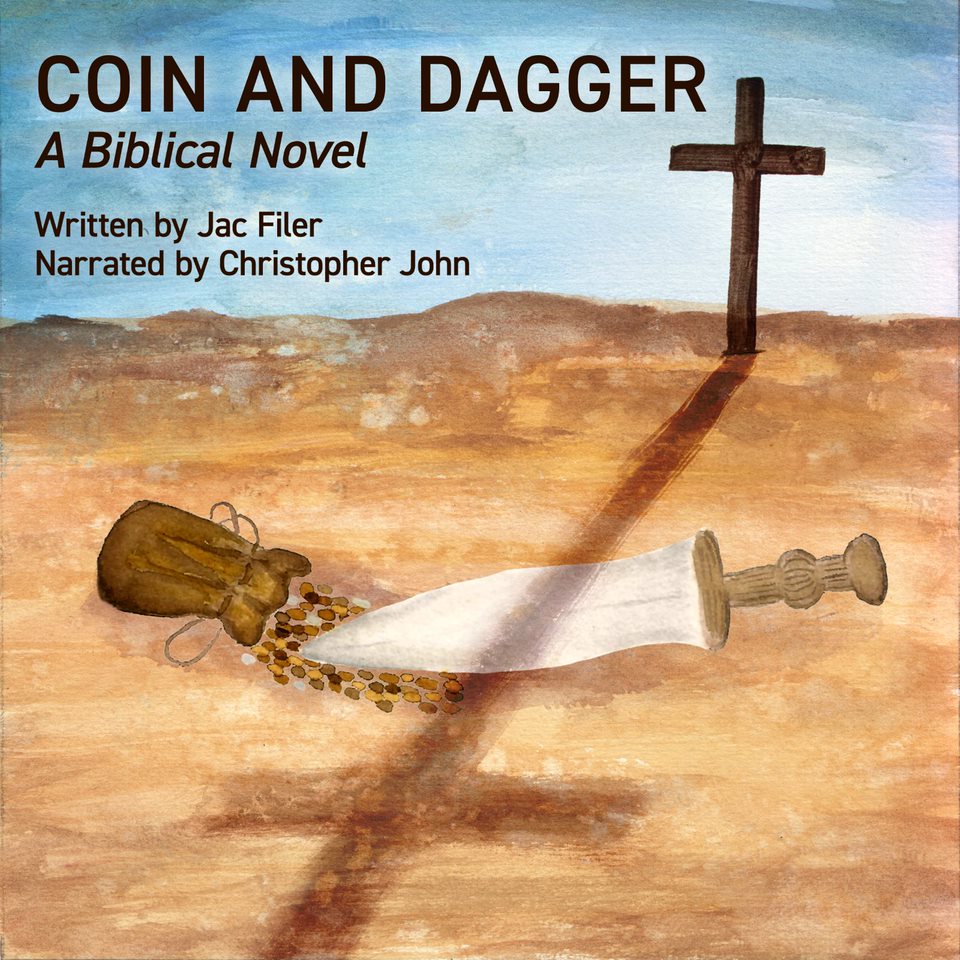I’m excited to share that my first novel, Coin and Dagger, is now available in audiobook format. Chris brought the characters to life with voices that expertly interpret and portray their unique personalities.

Not only did Jesus, Matthew, and Simon receive such careful treatment, but so did the supporting cast. In prior entries, we examined the roles that Bartimaeus and John Mark play in the story. Today, we’ll explore another minor character from Coin and Dagger.
Meeting Bar-Abbas
In scripture, Bar-Abbas (more commonly rendered Barabbas) famously appears in a single scene at the trial of Jesus. All four gospels mention him, with varying degrees of detail. John and Luke note only that when Pilate offered to release Jesus, the crowd asked instead for Barabbas, who was imprisoned after a recent uprising:
They shouted back, “No, not him! Give us Barabbas!” Now Barabbas had taken part in an uprising. – John 18:40 NIV
But the whole crowd shouted, “Away with this man! Release Barabbas to us!” (Barabbas had been thrown into prison for an insurrection in the city, and for murder.) – Luke 23:18-19 NIV
Mark adds one more detail:
A man called Barabbas was in prison with the insurrectionists who had committed murder in the uprising. – Mark 15:7 NIV
Matthew draws out the scene with a detailed exchange between Pilate and the crowd. He also shows that Pilate put forth Barabbas as a candidate for release alongside Jesus:
At that time they had a well-known prisoner whose name was Jesus Barabbas. So when the crowd had gathered, Pilate asked them, “Which one do you want me to release to you: Jesus Barabbas, or Jesus who is called the Messiah?” – Matthew 27:16-17 NIV
The ensuing dialogue demonstrates how Pilate even encouraged the crowd to request Jesus over Barabbas (Matthew 27:19-26).
Casting Bar-Abbas
If we read the passion narratives through a twenty-first-century lens, we might simply see a crowd that was so riled up against Jesus that they were willing to have a murderer in their midst in order to be rid of Jesus for good. It makes the modern reader wonder (as I did for many years) why anyone would choose Bar-Abbas over Jesus. A careful examination of Bar-Abbas sheds much-needed light on this question.
Bar-Abbas was more than just a street thug. He was a revolutionary with a political agenda. As such, a least some of the crowd would have been sympathetic to his cause, and willing to call for his release. Paradoxically, the Sanhedrin would not have necessarily held such a favorable view of Bar-Abbas. They simply saw Jesus as the greater threat to their station.
The high priests were appointed by the Roman prefect, and the Sanhedrin was dominated by the party of the Sadducees. In addition to doctrinal disagreements with the Pharisees, the Sadducees also held a more favorable view of Roman occupation. They had found a way to benefit from their foreign overlords, and enjoyed the regional power that came with their arrangement.
Though Jesus was no threat to the Romans, the Sanhedrin saw his increasing influence over the Judean people. They feared that if they could no longer maintain control over the people, the Romans would remove them from their place of prestige and power.
By contrast, though Sanhedrin looked unfavorably on the Zealots, they understood that Bar-Abbas would probably not bother them directly (and would likely be recaptured by Rome, anyway). I only needed a way to introduce Bar-Abbas into the story so that he wasn’t a stranger by the time we reached Jesus’ trial.
Scripting Bar-Abbas
In Coin and Dagger, Bar-Abbas makes his first appearance in Chapter 17, just after the mid-point of the book. Simon is expecting a clandestine meeting with his Zealot mentor, Manaen (an entirely fictional character). Instead, he meets a man who introduces himself as, “Jeshua, son of our fathers, Abraham, Isaac, and Jacob.” Simon puts the pieces together right away.
Before we examine Simon’s conclusions, let’s take some time to understand Bar-Abbas’ name. As I mentioned above, some ancient manuscripts of Matthew’s gospel record this individual as “Jesus Barabbas” or “Jesus who was called Barabbas.” This wording suggests that Jesus was his given name, and Barabbas was a moniker.
For the sake of reducing confusion, I chose to introduce him as Jeshua, using a variant rendition of the name Jesus. Now let’s dissect his moniker. Bar (son of) Abbas (fathers) translates, literally, to “the son of the fathers,” which is how Bar-Abbas introduces himself to Simon. In Coin and Dagger, I hyphenated his moniker to underscore the symbolism of its meaning.
Appealing to Israel’s patriarchs by name, Bar-Abbas reveals how his adopted patronym symbolizes tradition and Jewish identity, two ideals that are central to the vision and motivation of the Zealots in general, and Bar-Abbas in particular.
Understanding Bar-Abbas
From the first meeting, it is clear that Bar-Abbas is a leader in the Zealot movement. Simon already knows him by reputation, and others within the movement have also adopted the Bar-Abbas patronym. Jeshua Bar-Abbas is clearly aware of his station and his influence as a leader in the movement.
Still, Bar-Abbas struggles to make sense of Jesus. He is interested in Jesus’ miraculous powers and his capacity to attract large crowds. But he is at the same time puzzled by Jesus’ willingness to heal members of Roman households and welcome tax collectors.
In his meeting with Simon, Bar-Abbas does not hide his distaste for Matthew, nor his distrust of Jesus. Still, he contemplates whether Jesus could be useful to him.
This contemplation, though, is framed within the singular focus of Bar-Abbas’ revolutionary ideas and Zealotry. Bar-Abbas shows no indication of wanting to follow Jesus. He is only interested in determining if he can recruit Jesus, and use him for his own agenda.
Of course, the gospels reveal how this plays out. Ultimately, Jesus dies an insurrectionist’s death when he hangs on the very cross that Bar-Abbas had earned. So how could I incorporate this connection into a story centered around Simon and Matthew?
Portraying Bar-Abbas
Pairing Bar-Abbas with Simon was an obvious approach. Much the same way that John Mark served as a mirror for Matthew, Bar-Abbas fills this role in Simon’s story, but with one key difference. While John Mark allows Matthew to see who he once was and, in a sense, redeem his past, Bar-Abbas reveals a possible future to Simon.
When Simon meets Bar-Abbas, he is committed to following Jesus but still struggles with fully turning away from the ways of the Zealots. Ultimately, a shortsighted decision on Simon’s part places him on the receiving end of Bar-Abbas’ retribution, though the Zealot leader orchestrates his retaliation from a distance. It is as much Bar-Abbas’ lack of direct involvement as the violence itself that causes Simon to see the Zealot movement as yet another vehicle for oppression.
For their final encounter on the temple grounds, it seemed appropriate to use the writing prompt offered by the gospels and depict the uprising that led to Bar-Abbas’ arrest. By this time, Simon’s resolve is much more secure. When Bar-Abbas offers him a chance to return the Zealots, Simon rejects the opportunity and sticks with Jesus.
Would Simon have made the same choice earlier in the story? Not likely. Not because he would have rejected Jesus, but because it took him that long to understand that his old life and his new life were inherently at odds on all levels.
Like all of us who know Jesus, Simon’s transformation comes in a series of small steps. It’s only when we’ve walked some distance with Jesus that we can look back and realize how far he has brought us from where he found us.


